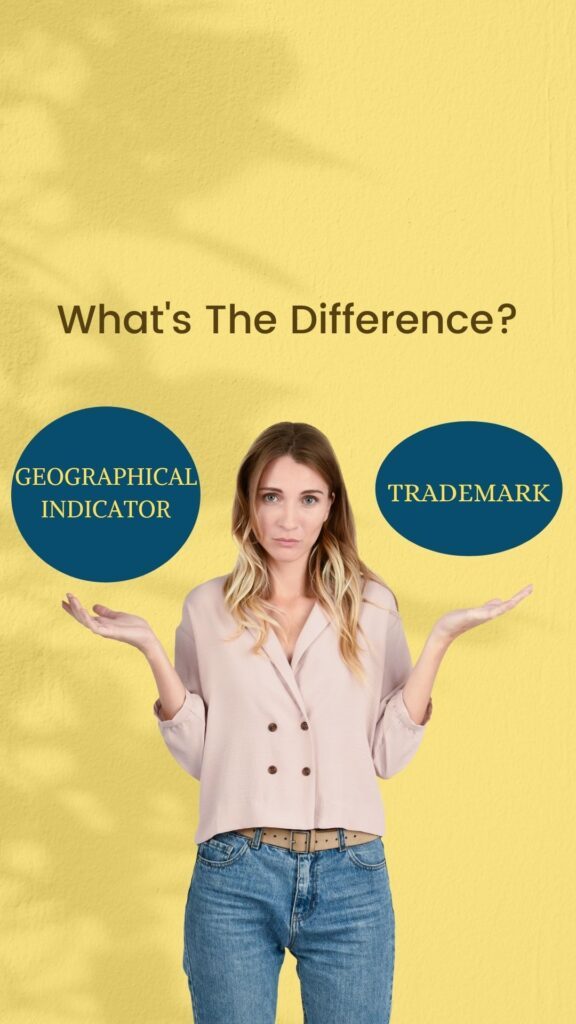What is the difference between Trademark and Geographical Indication? The concept of trademarks and geographical indications has been confused for so many years. However, there is nothing to confuse as the 2 terms are completely different. This blog will walk you through the basics of GIs and TMs along with specifying the clear difference between geographical indicators and trademarks.
Here is a quick rundown of the blog contents.
Let us first talk about geographical indications.
What is Geographical Indication in IPR?
As the name suggests, geographical indicators are used to indicate the geographical origin of a product and the distinct qualities due to its location. Further, a geographical indication tag tells the consumers that the specific product is manufactured or produced in a certain place & derives its properties due to its origin. E.g. Darjeeling tea is a GI tag specifying that the tea is produced from the small-leaved category of Camellia sinensis and not the large-leaved plants like other teas.
Some Geographical Indications examples are Swiss watches of Switzerland, Bashkir Honey of Russia, Tequila of Mexico, etc.
Key Features of Geographical Indications
- A geographical indication tag guarantees that the popular product name may only be used by individuals who have been registered as authorized users.
- Geographical indication protection is granted for products such as agricultural products, natural goods, handicrafts, food items, wines, spirits, etc.
- A geographical indication belonging to a country can be protected in another country as well. E.g. Cognac (a French GI tag) is recognized and protected in the USA.
- As it is used to savor and protect the unique, famous and traditional products of a specific geographical territory, the relationship between geographical indication and protection of traditional knowledge is quite prominent.
- The extent of the protection under geographical indication is confined to the traditional communities of the particular geographic area. This ensures that holders of traditional knowledge can’t transfer it to non-locales.
- Having a geographical indication empowers the authorized users to stop the third parties from providing products under the GI tag but not conforming to the standards or not producing in the specific geographical area.
- In places where the Mysore silk indication comes under the Geographical Indication Act. Producers of Mysore silk can prohibit the use of the word “Mysore” for tea not cultivated on their farms or prepared according to the requirements outlined in the geographical indicator’s code of practice.
Geographical Indication & WTO
The geographical indication concept is recognized by the TRIPS Agreement of the World Trade Organization mainly in Articles 22, 23 and 24.
Article 22 of the TRIPS Agreement
Contains all the GI products and standard protection provided to them under the law to prevent any misleading or unfair competition in the market.
Article 23 of the TRIPS Agreement
Goes one step ahead to cover wine and spirits. Article 23 specified that GI tags for wine & spirits are protectable even if their misuse is not misleading the general public.
Article 24 of the TRIPS Agreement
Article 24 contains exceptions and limitations on what can and cannot be protected under the GI umbrella.
Now that we know what geographical indication tags are, let’s move on to understanding the relationship and difference between geographical indications and trademarks.
What is the difference between geographical indications and trademarks?
Geographical indications are used to indicate the geographical origin of while the trademarks indicate the commercial origin of a product. While both are intellectual property tools, the former broadly define the origin and characters of a product category and latter its commercial background.
Example: Mysore Silk is a geographical indication example. Under this product category, producers can register their trademarks.
Difference Between Geographical Indication And Trademark.
| Geographical indication tag | Trademarks |
| Purpose of GI Tag IP tool used to indicate the origin of goods. |
Purpose of Trademarks IP tool is used to indicate the distinctiveness of a brand’s products or services or both. |
| GI Tag Rights A GI tag does not give exclusive rights of usage to a company |
Trademark Rights A registered trademark grants exclusive rights to the owner. |
| What Can Get A GI Tag? GI tags are granted for product categories: wines, tea, coffee, silk, cotton, rice, etc. |
What Can Be Trademarked? Trademarks are granted for brand logos, phrases, business names, etc. |
| Geographical indications are given to a group of manufacturers or communities from the same. | Trademarks are given to brand and company owners. |
| Ownership of GI Tag A group of people who get a GI tag become an authorized users of the GI tag, not its owner. Other producers from the same area can also get the same tag. |
Ownership of Trademarks The person who gets a trademark becomes its owner with trademark rights over its usage and transfer. No one else can use the trademark except under a few conditions. If someone infringes upon the plaintiff’s trademark rights, they are liable for criminal punishment. |
| Geographical indication tags can either be names or symbols coming from a specific region. | Trademark can be: Word Symbol Letter Smell Sound Device |
| Who Can Apply for a GI tag? A person, producer, or authority set up by or under the law is eligible to apply for the registration of Geographical Indication of their product if The Applicant represents the interest of producers. The Application is submitted in a prescribed form (GI-1A to ID) containing all the information. |
Who Can Apply For a Trademark? A company owner or individual with a unique logo/symbol/phrase that distinguishes their brand from others. |
| GI Tag Fee in India General Fee is 5000, however, you may need to pay extra in case of getting a time extension, a notice of opposition, etc. Check the complete GI Tag fee breakdown here. |
Trademark Registration Fee in India For MSMEs/Startups/Individuals: INR 5000 for physical filing & 4500 for e-filing For Companies: INR 10000 for physical filing & 9000 for e-filing. Check this link for complete breakdown of trademark registration fee in India. |
The 3 striking similarities between trademarks and geographical indication tags are:
- Both are forms of intellectual property.
- Both have a life of 10 years and are renewable thereafter.
- GI and Trademarks act as the source of indicators, former for the origin and latter for the company/brand.
Can a GI be registered as a trademark?
No, one can’t register Geographical Indicators as trademarks because:
- Registering GIs as trademarks will make them the sole IP property of the trademark owner.
- This will negate the whole idea of protecting traditional knowledge and special products produced by a group or community in a specific place.
Looking to Register a Trademark for Your Business? TMReady Is Here to Help.
With decades of expertise in intellectual property and a team of dedicated professionals, TMReady is your go-to source for comprehensive trademark solutions. Whether you’reseeking to:
- Professional Trademark Search Services— thorough and detailed searches across multiple regions to ensure your logo is protected.
- Reliable Trademark Monitoring Services — keeping an eye on your trademark to detect potential infringements or safeguard unconventional trademarks.
Our services offer transparent pricing and exceptional value, ensuring your brand is fully protected.





